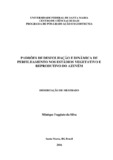| dc.creator | Silva, Mônique Foggiato da | |
| dc.date.accessioned | 2016-08-30 | |
| dc.date.available | 2016-08-30 | |
| dc.date.issued | 2016-01-27 | |
| dc.identifier.citation | SILVA, Mônique Foggiato da. Patters of defoliation and tillering dynamics of stages vegetative and reproductive of ryegrass. 2016. 82 f. Dissertação (Mestrado em Zootecnia) - Universidade Federal de Santa Maria, Santa Maria, 2016. | por |
| dc.identifier.uri | http://repositorio.ufsm.br/handle/1/10915 | |
| dc.description.abstract | The study was conducted with the objective to evaluate the intensity and frequency of defoliation and the tillering dynamics of ryegrass (Lolium multiflorum Lam.) of stages vegetative and reproductive, under rotational grazing. The interval between grazings was set by the thermal sum required for the appearing of 1.5 ryegrass leave (187.5 ºGD). The experimental design was completely randomized, with two phenological stages and six replicated areas for each stage. In the vegetative stage, the intensity defoliation (54%) it was similar in the different types of leaf blades. In the reproductive stage, the intensity of grazing was higher in leaves growing (78%) in relation to the expanded and senescent leaves (67%). Heifers explored 16.7% more grazing area in the reproductive stage compared to vegetative. The most removal intensity the leaves of expansion and the higher frequency defoliation are compensatory mechanisms used by animals when the ryegrass is located the reproductive stage. The first generation of tillers have greater longevity compared to other generations, contributing 58% of total tillers in the late vegetative stage of ryegrass and 36% of tillers in the last month of pasture utilization. The population of tillers in vegetative and reproductive stages of pasture is maintained stable when the ryegrass pasture is managed in a rotational system, considering the thermal sum of 187.5 ºGD and canopy height in the exit of the animals of the plots around 10 cm. | eng |
| dc.format | application/pdf | por |
| dc.language | por | por |
| dc.publisher | Universidade Federal de Santa Maria | por |
| dc.rights | Acesso Aberto | por |
| dc.subject | Bezerras de corte | por |
| dc.subject | Frequência de desfolhação | por |
| dc.subject | Intensidade de desfolhação | por |
| dc.subject | Lolium multiflorum Lam. | por |
| dc.subject | Método rotativo | por |
| dc.subject | Variáveis estruturais | por |
| dc.subject | Beef heifers | eng |
| dc.subject | Frequenyi of defoliation | eng |
| dc.subject | Intensity of defoliation | eng |
| dc.subject | Rotational method | eng |
| dc.subject | Structural variables | eng |
| dc.title | Padrões de desfolhação e dinâmica de perfilhamento nos estádios vegetativo e reprodutivo do azevém | por |
| dc.title.alternative | Patters of defoliation and tillering dynamics of stages vegetative and reproductive of ryegrass | eng |
| dc.type | Dissertação | por |
| dc.description.resumo | O trabalho foi realizado com o objetivo de avaliar a intensidade e frequência de desfolhação e a dinâmica de perfilhamento do azevém (Lolium multiflorum Lam.) nos estádios vegetativo e reprodutivo, sob pastejo rotacionado. O intervalo entre pastejos foi estabelecido considerando a soma térmica necessária para a emissão de 1,5 folha de azevém (187,5º GD). O delineamento experimental foi inteiramente casualizado, com dois estádios fenológicos e seis repetições de área para cada estádio. No estádio vegetativo, a intensidade de desfolhação (54%) foi semelhante nos diferentes tipos de lâminas foliares. No estádio reprodutivo, a intensidade de desfolhação foi superior nas folhas em expansão (78%) em relação às folhas expandidas e senescendo (67%). As bezerras exploraram 16,7% a mais a área de pastejo no estádio reprodutivo em relação ao vegetativo. A maior intensidade de remoção de folhas em expansão e a maior frequência de desfolhação são os mecanismos compensatórios utilizados pelos animais quando o azevém encontra-se no estádio reprodutivo. A primeira geração de perfilhos tem maior longevidade em relação às demais gerações, contribuindo com 58% do total de perfilhos no final do estádio vegetativo do azevém e 36% do total de perfilhos no último mês de utilização da pastagem. A população de perfilhos nos estádios vegetativo e reprodutivo do pasto é mantida estável quando a pastagem de azevém é manejada em sistema rotacionado, considerando a soma térmica de 187,5 ºGD e com a altura do dossel na saída dos animais das parcelas ao redor de 10 cm. | por |
| dc.contributor.advisor1 | Rocha, Marta Gomes da | |
| dc.contributor.advisor1Lattes | http://lattes.cnpq.br/1685524901627774 | por |
| dc.contributor.referee1 | Pötter, Luciana | |
| dc.contributor.referee1Lattes | http://lattes.cnpq.br/0683474086643296 | por |
| dc.contributor.referee2 | Machado, Juliana Medianeira | |
| dc.contributor.referee2Lattes | http://lattes.cnpq.br/7184654849732716 | por |
| dc.creator.Lattes | http://lattes.cnpq.br/2920551248222949 | por |
| dc.publisher.country | BR | por |
| dc.publisher.department | Zootecnia | por |
| dc.publisher.initials | UFSM | por |
| dc.publisher.program | Programa de Pós-Graduação em Zootecnia | por |
| dc.subject.cnpq | CNPQ::CIENCIAS AGRARIAS::ZOOTECNIA | por |


